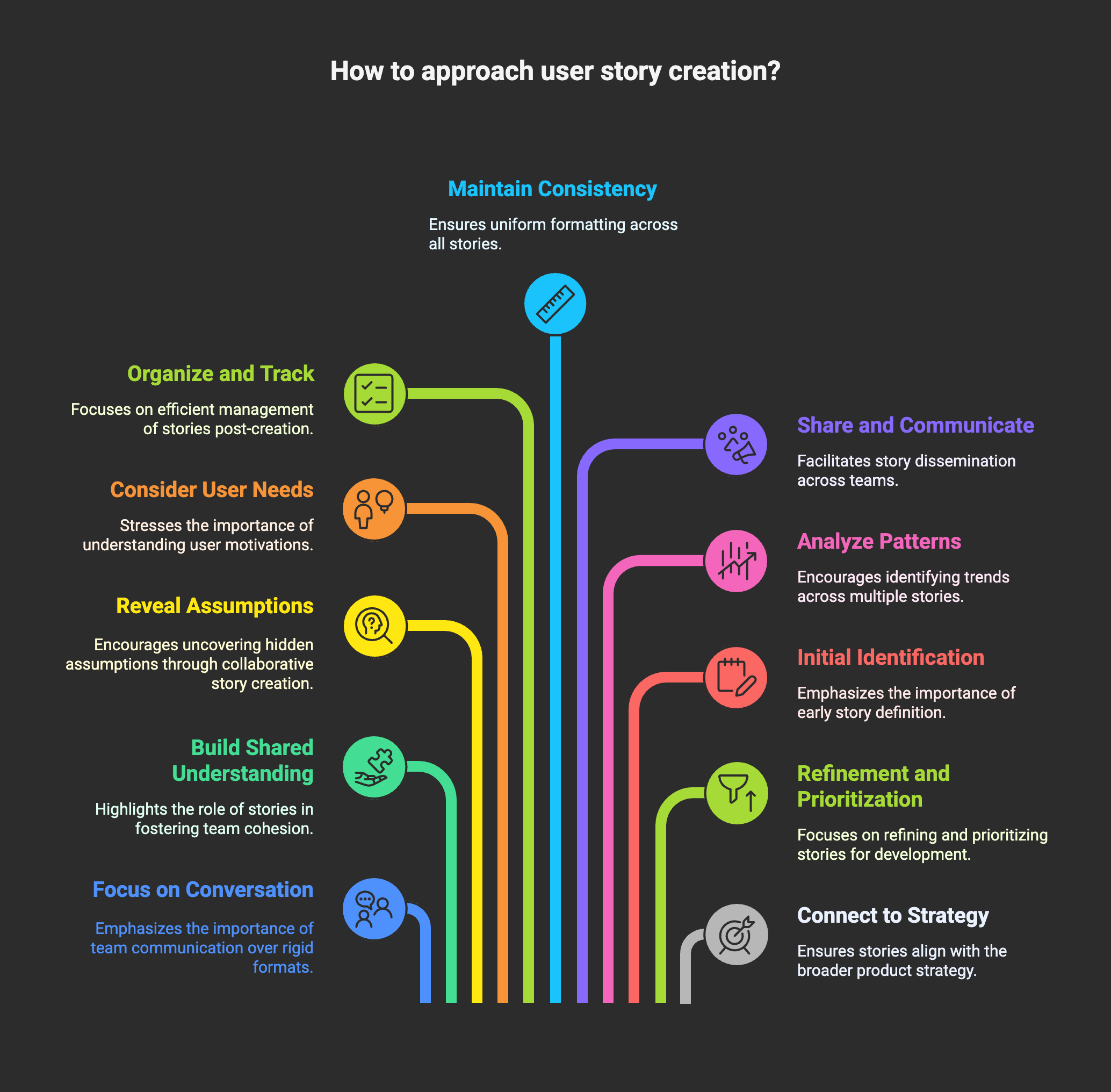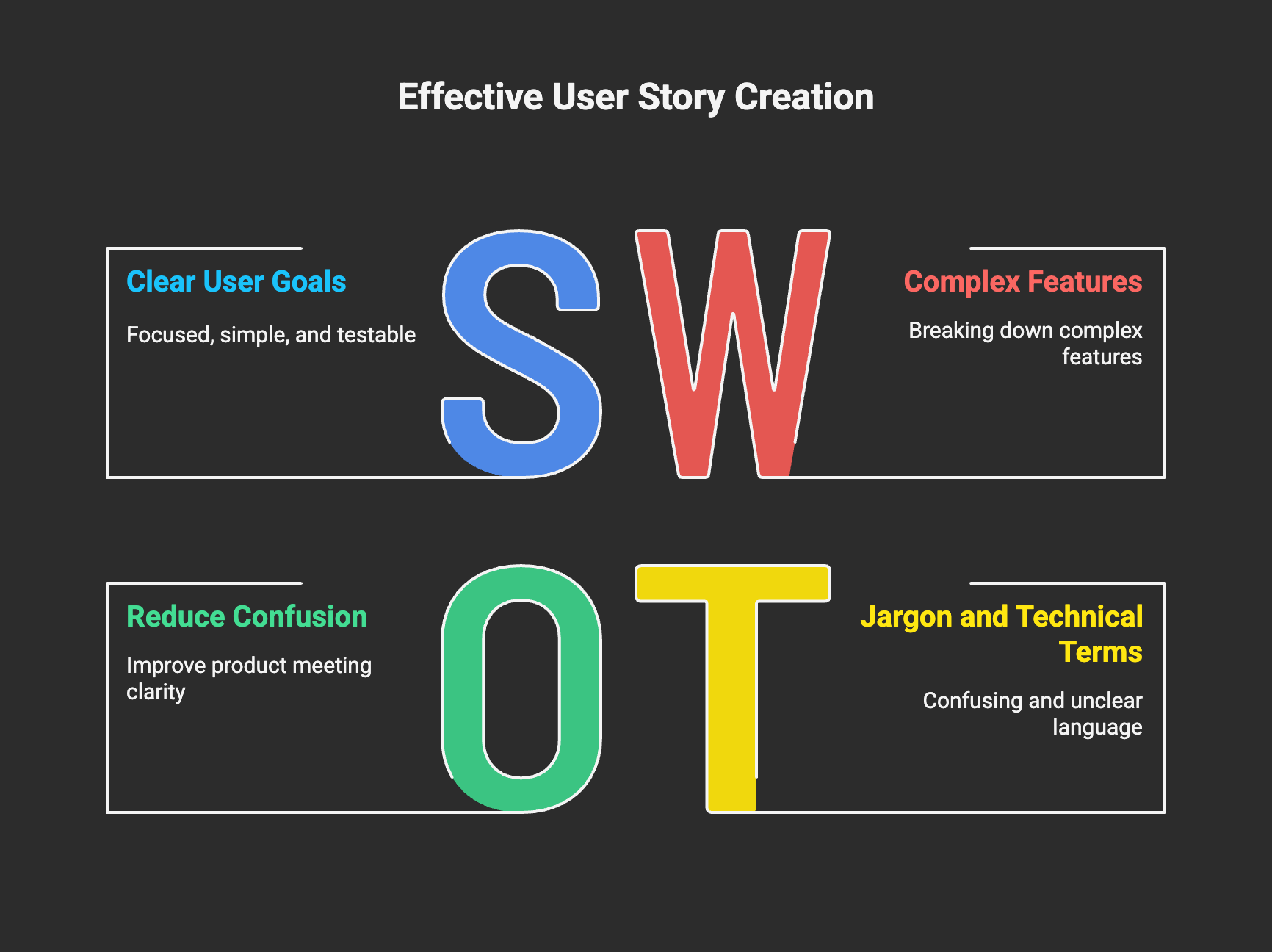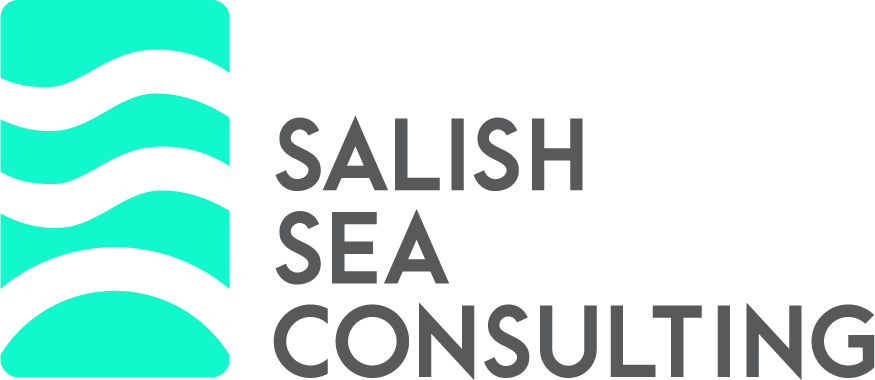User Story Writing and Building Shared Understanding

User story writing helps you capture what your users need in a simple way. But their real power comes from the conversations they inspire. They keep your team focused on real problems instead of getting lost in technical details by creating a shared understanding of user needs.
Looking for a clear way to align your team around user value?
Need a method to ensure everyone understands not just what to build, but why it matters?
User story writing gives you a framework for these critical conversations. You'll see how collaborative story creation shapes your project and helps everyone move in the same direction with a deeper understanding of user needs.
What Is User Story Writing?
User story writing helps you capture your user's needs in a clear and simple format.
You create short sentences that describe what a user wants and why.
You focus on the people using your product, not just technical features.
Key parts of a user story:
- User: Who wants something? For example, your customer or team member.
- Goal: What do they want to do? For example, book an appointment or upload a file.
- Reason: Why do they want it? For example, save time or share information.
A standard template:
- "As a [user], I want [goal], so that [reason]."
Examples:
- "As a new user, I want to sign up quickly so that I can access my dashboard right away."
- "As an admin, I want to edit user permissions so that I can keep the system secure."
You share user stories with your team so everyone knows the user's needs.
You use stories during planning meetings to guide what features you build next.
The Human Element in User Story Writing
While structure is important, the greatest value comes from the collaborative conversations that user stories inspire. As product expert Kent McDonald notes, "Stories get their name from how they should be used, not what should be written."
Remember these principles when approaching user story creation:
- The conversation matters more than the format
- User stories build shared understanding among team members
- The process of creating stories together reveals assumptions and gaps
- Writing is only the artifact of deeper thinking about user needs
When to Use Tools:
- To organize and track stories after collaborative creation
- To maintain consistent formatting once the content is established
- To share and communicate stories across distributed teams
- To analyze patterns across many stories
When to Rely on Human Collaboration:
- During initial story identification and creation
- When determining user needs and motivations
- For refinement and prioritization discussions
- When connecting stories to broader product strategy

Key Elements of a Good User Story
Clear user stories help your team focus on what matters. Strong stories break down user needs with context, purpose, and clarity.
The Role of "As a, I want, So that"
- Break user stories into three direct parts using "As a, I want, So that."
- Pinpoint the user with "As a" (e.g., "As a new customer").
- State the exact goal with "I want" (e.g., "I want to sign up quickly").
- Tie every goal to a reason using "So that" (e.g., "So that I can start using the product without delay").
- Keep each part short. Use one sentence per section.
- Ask yourself: Does the story explain who, what, and why?
Importance of Acceptance Criteria
- Acceptance criteria set detailed benchmarks for each user story.
- Define clear steps for completion (e.g., "User receives a confirmation email after signing up").
- Test your criteria by asking: Can you check off each item when done?
- Use bullet points for clarity (e.g., "Sign-up form accepts valid emails," "Password reset option appears after three failed logins").
- Guide team discussions with concrete, checkable outcomes.
Do your stories explain the user's goal from the user's view? Are your acceptance criteria measurable and testable? Use these checks to tighten your user story writing.
Best Practices for User Story Writing
Keep user stories direct, user-focused, and easy to understand. Clear writing helps your team grasp needs quickly and act without confusion.
Keeping Stories Simple and Concise
- Write each user story using a single user goal.
- Use plain language that avoids jargon and technical terms.
- Break complex features into multiple stories when possible.
Key phrases:
- "As a new customer, I want to see product ratings so I can compare products easily" covers one goal.
- Short stories reduce confusion during product meetings.
- Simple stories help testers confirm when work meets goals.
Do your longest stories explain more than one user need? Split them for clarity.

Focusing on User Value
- Describe user stories from the user's viewpoint.
- Tie each story to a specific need or benefit the user receives.
- Back up stories with real user feedback or insights.
Add context:
- "As a team lead, I want to filter reports by date so I can review trends quickly" connects the feature with why it's valuable.
- Stories that focus on user value lead to higher user satisfaction after release.
- Team discussions on user value clear up differences before development starts.
Are your stories tied to business priorities that matter to users? Check if the benefit is clear in each one.
Common Mistakes in User Story Writing
Effective user story writing keeps teams on track and strengthens product value. Avoiding common mistakes helps you deliver clear direction and focus on real user needs.
Overcomplicating Stories
- Write stories that stay short and focused on a single goal. If you try to cover multiple user needs in one story, your team may miss critical details.
- Use one sentence for the user's intent. For example, "As a frequent traveler, I want to save favorite destinations, so that I can book faster."
- Break complex features into smaller stories. Ask yourself: could another team member quickly understand and act on this story alone?
- Remove technical details. Technical implementation shouldn't dominate the user's request.
- Test understanding within your team. If someone can't explain the story in under 30 seconds, the story needs simplification.
Neglecting Collaboration
- Write stories with team input. If you write in isolation, you leave gaps and risk missing user or technical perspectives.
- Hold regular story grooming sessions. These meetings let designers, developers, and testers share context using real user needs.
- Use feedback to shape acceptance criteria. For instance, after getting developer feedback, you might clarify "save destinations" to specify a limit or display order.
- Invite stakeholders. Input from product owners or actual users ensures priorities match expectations.
- Ask in meetings: does this story reflect what users value most today? If not, collaborate more before moving forward.
A Transformation Workshop
This step-by-step workshop helps transform vague requirements into well-structured user stories:
Workshop Steps:
- Identify the users: Who needs this functionality?
- Clarify the goals: What specific capabilities do they need?
- Understand the reasons: Why is this important to them?
Example Transformation:
Vague requirement: "The app needs a better search function."
Workshop process:
- Users identified: Researchers, casual users, data analysts
- Goals clarified: Different search capabilities for different user types
- Reasons established: Efficiency, data access, recurring analysis needs
Resulting user stories:
- "As a researcher, I want to search by publication date, so that I can find the most recent studies."
- "As a casual user, I want search suggestions as I type, so that I can find information faster."
- "As a data analyst, I want to save my search filters, so that I can run the same queries regularly."
Tools to Support the User Story Process
The right tools enhance the collaborative nature of user stories rather than replacing the human conversations at their core. Here's a curated selection of platforms that support different aspects of the user story lifecycle:
Collaborative Discovery and Creation
1. Miro
Visual collaboration boards that facilitate remote user story mapping workshops, helping teams collectively discover and organize stories based on user journeys. Miro shines during initial story identification sessions where team alignment is crucial.
2. TheyDo
Connects user stories directly to journey maps and research insights, ensuring that your stories remain grounded in actual user needs rather than assumptions. Use it to maintain strong links between user research and the stories that emerge from that research.
3. QOQO
This AI-powered platform can analyze user research data and suggest potential user stories, serving as a starting point for team discussions—not a replacement for them. Most valuable when you have abundant user research that needs initial synthesis.
4. Lucidspark
Offers dedicated templates for agile activities and story mapping with real-time collaboration features. Its structured canvas helps distributed teams simulate the energy and visual organization of in-person story workshops.
Documentation and Refinement
5. Jira
The industry standard for tracking user stories through their lifecycle. While not ideal for the creative aspects of story writing, Jira excels at maintaining structure once stories have been collaboratively created and discussed.
6. Notion
Provides flexible databases and templates for organizing user stories alongside related information like personas and product documentation. Its versatility makes it ideal for teams who want to build a custom system that matches their exact workflow.
7. Cycle
Features specialized "refinement rooms" designed specifically for the collaborative discussion and clarification of user stories. Use it to transform initial story ideas into well-defined stories with clear acceptance criteria through structured team conversation.
8. Whimsical
A lightweight tool for quickly creating flowcharts and story maps that help visualize relationships between user stories. Its speed and simplicity make it valuable for teams who need to rapidly organize stories during live discussions.
Strategic Alignment and Prioritization
9. ProductBoard
Excels at prioritizing user stories based on customer feedback and calculated impact scores. It helps answer the critical question: "Of all possible stories, which ones should we focus on next to deliver the most value?"
10. Userwell
Collects and organizes user feedback from multiple channels, transforming it into potential user stories. This maintains a continuous connection between evolving user needs and your backlog.
11. Avion
Creates living product roadmaps connected to user stories, providing strategic context for why each story matters. It helps teams understand how individual stories contribute to larger features and releases.
Finding the Right Balance
Remember Kent McDonald's wisdom: "The user stories you write and don't write are far more important than how you write them." The best tools support this philosophy by:
- Enhancing collaboration, not replacing human conversations
- Providing context that connects stories to user needs and product strategy
- Maintaining structure without imposing rigid formats that stifle creativity
- Supporting prioritization so teams focus on stories that truly matter
When evaluating these tools, consider which aspects of your user story process need the most support, and select accordingly. No tool should replace the collaborative conversations that are at the heart of effective user stories.
A Note on AI-Generated User Stories
⚠️ While AI tools for generating user stories are increasingly available, they risk undermining the core purpose of user stories: building shared understanding through conversation. Consider Kent McDonald's warning that "Trying to automate the activities that require collaboration with your product team is not [the right] place" for AI.
If you do use AI in your user story process:
- Use it to help refine formatting after collaborative creation
- Leverage it for analyzing patterns across existing stories
- Consider it for generating test cases from established stories
- Avoid using it to replace the human conversation and discovery process
Remember: The value of user stories lies not in their written form but in the shared understanding they create among team members.
Measuring User Story Effectiveness
To ensure your user stories are serving their purpose, track these key metrics:
Metrics to Consider:
- Story completion rate: Are stories consistently completed within sprints? Low completion rates may indicate stories are too large or poorly defined.
- Rework percentage: How often do stories need significant revision after development? High rework suggests gaps in shared understanding.
- User satisfaction alignment: Do completed stories match actual user needs? Regularly validate with real users to ensure stories translate to value.
- Team understanding: Can all team members explain the purpose of current stories? Regular spot checks can reveal communication gaps.
Implementation Tips:
- Conduct brief (5-minute) retrospectives after each story to capture learnings
- Track the "age" of stories from creation to completion - fresher is usually better
- Monitor stories that get repeatedly deprioritized, as they may not be valuable
- Periodically validate completed stories against actual user behavior
Scaling Your User Story Approach
Adapt your approach based on project size and complexity:
For Small Projects (1-3 team members):
- Simple Trello board with 3 columns (To Do, Doing, Done)
- Lightweight story format focusing on functionality
- Weekly prioritization session
- Stories discussed in person as needed
For Medium Projects (4-10 team members):
- Story mapping with monthly prioritization
- Dedicated refinement sessions twice per month
- Structured acceptance criteria
- Tool integration between story tracking and development
For Large Enterprises (multiple teams):
- Hierarchical story structure with portfolio alignment
- Formalized templates and consistent formatting
- Cross-team story dependencies clearly mapped
- Regular synchronization between product and development
- Strategic alignment through tools like Avion or ProductBoard
Conclusion
Mastering user story writing gives your team a clear path to building products that genuinely meet user needs. When you focus on what matters to your users and keep your stories concise and actionable, you'll see stronger alignment and better results.
Keep refining your approach and encourage open discussions with your team. With the right mindset and tools, you'll create user stories that drive value and set your projects up for success.
Remember that the value lies not in perfectly formatted stories, but in the shared understanding they create among team members. As Kent McDonald emphasizes, "The user stories you write and don't write are far more important than how you write them."
Frequently Asked Questions
What is a user story in product development?
A user story is a short, simple description of a feature from the perspective of the person who needs it. It typically follows the structure: "As a [user], I want [goal], so that [reason]." User stories help teams understand user needs and focus on delivering features that create real value for users.
Why are user stories important?
User stories keep the team's focus on real user problems and goals, not just technical requirements. They make it easier to prioritize work, improve communication among team members, and ensure that product development always addresses actual user needs and delivers meaningful value.
What are the key components of a user story?
The key components are: the user (who wants something), the goal (what they want), and the reason (why they want it). User stories also include acceptance criteria, which define when the story is complete and working as intended.
How should a good user story be written?
A good user story should be brief, clear, and user-focused. It should use simple language, be easy to understand, and state the goal and why it matters. Each story should address a single user need, not combine multiple requirements.
What is the common format for user stories?
The most common format is: "As a [user], I want [goal], so that [reason]." This structure helps clarify who the user is, what they want, and why they want it, making it easier for the team to prioritize and build the right features.
Why are acceptance criteria important in user stories?
Acceptance criteria set clear expectations for what it means to complete the user story successfully. They are measurable and testable steps that help teams know when a feature is done and ensure the final product meets user needs.
What are some best practices for writing user stories?
Use simple, plain language. Focus on a single user and one specific goal per story. Break down complex features into smaller stories. Include acceptance criteria and gather feedback from your team and stakeholders for clarity and effectiveness.
What are common mistakes when writing user stories?
Common mistakes include making stories too broad or covering multiple needs in one story, using technical jargon, or not involving the team in creating or refining stories. These errors can lead to confusion and features that don't truly address user needs.
How can teams collaborate effectively on user stories?
Teams should write stories together, hold regular grooming or review sessions, and invite input from all stakeholders. Collaboration ensures all perspectives are heard, user needs are accurately captured, and stories remain clear and actionable.
What tools are useful for managing user stories?
Popular tools include Jira, Notion, and specialized platforms like TheyDo and ProductBoard. The best tool depends on your team's specific needs, with options ranging from visual collaboration tools like Miro to dedicated story mapping solutions.
Should we use AI to write our user stories?
While AI tools can help with formatting or analyzing patterns in existing stories, they shouldn't replace the collaborative human process of creating and discussing user stories. The primary value of user stories comes from the shared understanding they build among team members, which requires human conversation and insight.




